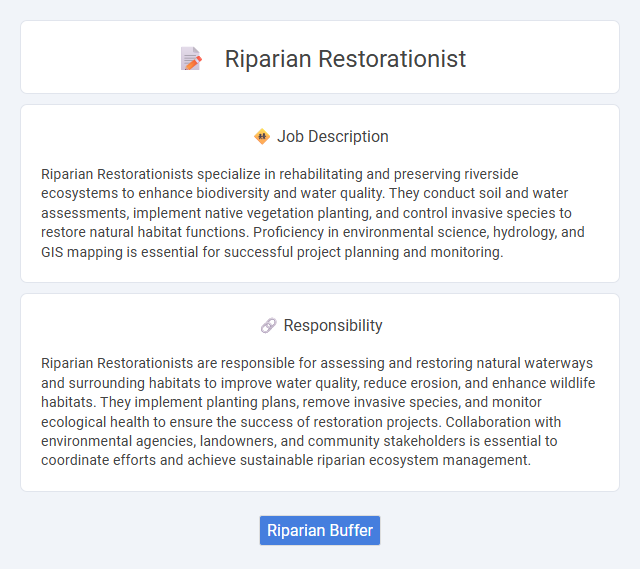
Riparian Restorationists specialize in rehabilitating and preserving riverside ecosystems to enhance biodiversity and water quality. They conduct soil and water assessments, implement native vegetation planting, and control invasive species to restore natural habitat functions. Proficiency in environmental science, hydrology, and GIS mapping is essential for successful project planning and monitoring.
Individuals with a strong passion for environmental conservation and an ability to work outdoors in variable weather conditions are likely to be suitable for a Riparian Restorationist role. Those who possess physical stamina, attention to detail, and skills in ecological assessment will probably find this job fulfilling and manageable. People who prefer routine office work or have limited interest in hands-on ecological projects may not be well-suited to this position.
Qualification
Riparian restorationists typically require a background in environmental science, ecology, or natural resource management, often holding a bachelor's or advanced degree in these fields. Proficiency in botany, hydrology, and soil science is essential to assess and rehabilitate riparian zones effectively. Experience with habitat restoration techniques, GIS mapping, and environmental regulations enhances their ability to develop and implement sustainable restoration projects.
Responsibility
Riparian Restorationists are responsible for assessing and restoring natural waterways and surrounding habitats to improve water quality, reduce erosion, and enhance wildlife habitats. They implement planting plans, remove invasive species, and monitor ecological health to ensure the success of restoration projects. Collaboration with environmental agencies, landowners, and community stakeholders is essential to coordinate efforts and achieve sustainable riparian ecosystem management.
Benefit
Riparian restorationists likely enhance ecosystem health by improving water quality and stabilizing stream banks, which can benefit biodiversity and reduce erosion. Their work probably supports habitat connectivity, aiding wildlife populations and promoting natural flood control. Engaging in this role may also contribute to community resilience by restoring natural landscapes and providing educational opportunities.
Challenge
Riparian restorationist roles likely involve managing complex environmental challenges such as soil erosion, invasive species, and fluctuating water quality. Addressing these issues requires adaptive strategies that balance ecological health with human activities. The probability of encountering unpredictable weather patterns and regulatory constraints may further complicate project outcomes.
Career Advancement
Riparian restorationists enhance their career prospects by gaining expertise in ecosystem management, hydrology, and native plant species, which are critical for successful habitat rehabilitation. Advanced certifications and experience with GIS technology and environmental regulations increase employability in government agencies, non-profits, and consulting firms. Networking with environmental scientists and participating in specialized training programs accelerates progression to senior project management and policy advisory roles in riparian restoration.
Key Terms
Riparian Buffer
Riparian restorationists specialize in enhancing riparian buffers to improve water quality, control erosion, and support habitat biodiversity along waterways. These professionals implement native vegetation planting, invasive species removal, and soil stabilization techniques to restore natural streambank functions. Effective riparian buffer management is critical for watershed health and mitigating the impacts of urban and agricultural runoff.
 kuljobs.com
kuljobs.com